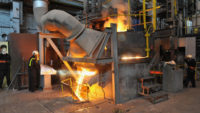Concrete recycling could be key to post-war construction in Ukraine, according to a research team from Ukrainian, Swiss and French universities. Having recycled little in the past, Ukraine could generate abundant reconstruction aggregate from an estimated 25-million to 40-million cu yd of building and infrastructure rubble.
“If we can recycle and reuse demolition waste on site, we can minimize [logistical] expenses,” notes co-researcher Viacheslav Troian, a professor at the Kyiv National University of Construction and Architecture, now working at Switzerland’s ETH Zurich.
Troian, with collaborators from ETH and France's Navier Laboratory, believe pre-wetting crushed concrete would be the best option for overcoming quality deficiencies in recycled coarse aggregate in the quantities required.
"Other technologies do not appear advanced enough for a rapid rollout at the scale that would be needed in Ukraine," they conclude in a report published by the International Union of Laboratories and Experts in Construction Materials, Systems and Structures.
By this June, the Russian invasion had caused nearly $40 billion of residential building damage, according to the team. Highways suffered another $30 billion worth of loss.
As well as replacing damaged infrastructure, Ukraine has a housing renewal backlog exceeding 43 million sq ft. "For example, in Kyiv, about 70% of precast concrete houses built from 1950‐70 are in critical condition," reports the team. More than 260 million cu yd of old concrete in residential buildings "needs to be replaced in the coming decades."
However, depending on how aggregates are recycled, "concrete may be characterized by poor workability, reduced mechanical properties, increased shrinkage and reduced durability," caution the researchers. These flaws are largely due to the presence of old cement mortar in the aggregate surface which absorbs liquids.
Of various available corrective measures, pre-wetting of the aggregate "could best be achieved by two‐stage mixing and could probably find its way in regular practice in [such] a constrained market," conclude the researchers.








